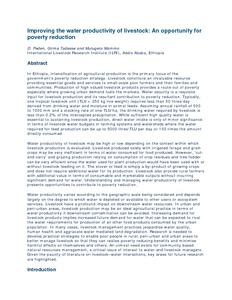Resource information
In Ethiopia, intensification of agricultural production is the primary focus of the government’s poverty reduction strategy. Livestock constitute an invaluable resource providing essential goods and services to small-scale poor farmers and their families and communities. Production of high valued livestock products provides a route out of poverty especially where growing urban demand fuels the markets. Water security is a requisite input for livestock production and its resultant contribution to poverty reduction. Typically, one tropical livestock unit (TLU = 250 kg live weight) requires less than 50 litres/day derived from drinking water and moisture in animal feeds. Assuming annual rainfall of 500 to 1000 mm and a stocking rate of one TLU/ha, the drinking water required by livestock is less than 0.2% of the intercepted precipitation. While sufficient high quality water is essential to sustaining livestock production, direct water intake is only of minor significance in terms of livestock water budgets in farming systems and watersheds where the water required for feed production can be up to 5000 litres/TLU per day or 100 times the amount directly consumed.
Water productivity of livestock may be high or low depending on the context within which livestock production is evaluated. Livestock produced solely with irrigated forage and grain crops may be very inefficient in terms of water consumed for food produced. However, ‘cut-and-carry’ and grazing production relying on consumption of crop residues and tree fodder can be very efficient since the water used for plant production would have been used with or without livestock feeding on it. The stover or feed is simply a by-product of growing crops and does not require additional water for its production. Livestock also provide rural farmers with additional value in terms of consumable and marketable outputs without incurring significant demand for water. Understanding and managing water productivity of livestock presents opportunities to contribute to poverty reduction.
Water productivity varies according to the geographic scale being considered and depends largely on the degree to which water is depleted or available to other users or ecosystem services. Livestock have a profound impact on downstream water resources. In urban and peri-urban areas, livestock production may be an ideal agricultural practice in terms of water productivity if downstream contamination can be avoided. Increasing demand for livestock products implies increased future demand for water that can be expected to rival the water requirements for production of all other food products consumed by the urban population. In many cases, livestock management practices jeopardise water quality, human health and aggravate water mediated land degradation. Research is needed to develop practical strategies to enable poor people in rural, peri-urban and urban areas to better manage livestock so that they can realise poverty reducing benefits and minimise harmful effects on themselves and others. An utmost need exists for community based natural resources management, a critical issue of interest to water and livestock managers. Given the paucity of literature on livestock–water interactions, key areas for future research are highlighted.



